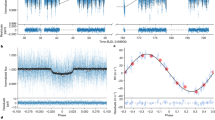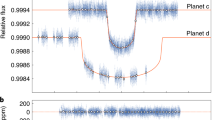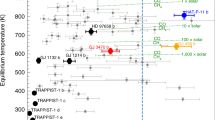Abstract
Since the discovery of the first exoplanets1,2, it has been known that other planetary systems can look quite unlike our own3. Until fairly recently, we have been able to probe only the upper range of the planet size distribution4,5, and, since last year, to detect planets that are the size of Earth6 or somewhat smaller7. Hitherto, no planets have been found that are smaller than those we see in the Solar System. Here we report a planet significantly smaller than Mercury8. This tiny planet is the innermost of three that orbit the Sun-like host star, which we have designated Kepler-37. Owing to its extremely small size, similar to that of the Moon, and highly irradiated surface, the planet, Kepler-37b, is probably rocky with no atmosphere or water, similar to Mercury.
This is a preview of subscription content, access via your institution
Access options
Subscribe to this journal
Receive 51 print issues and online access
$199.00 per year
only $3.90 per issue
Buy this article
- Purchase on Springer Link
- Instant access to full article PDF
Prices may be subject to local taxes which are calculated during checkout

Similar content being viewed by others
References
Mayor, M. & Queloz, D. A Jupiter-mass companion to a solar-type star. Nature 378, 355–359 (1995)
Marcy, G. & Butler, R. P. A planetary companion to 70 Virginis. Astrophys. J. 464, L147–L151 (1996)
Fabrycky, D. C. et al. Architecture of Kepler’s multi-transiting systems: II. New investigations with twice as many candidates. Astrophys. J.. (submitted); preprint at http://arxiv.org/abs/1202.6328 (2012)
Howard, A. W. et al. The occurrence and mass distribution of close-in super-Earths, Neptunes, and Jupiters. Science 330, 653–655 (2010)
Howard, A. W. et al. Planet occurrence within 0.25 AU of solar-type stars from Kepler. Astrophys. J. 201 (suppl.). 15 (2012)
Fressin, F. et al. Two Earth-sized planets orbiting Kepler-20. Nature 482, 195–198 (2011)
Muirhead, P. S. et al. Characterizing the cool KOIs. III. KOI 961: a small star with large proper motion and three small planets. Astrophys. J. 747, 144 (2012)
Archinal, B. A. et al. Report of the IAU Working Group on Cartographic Coordinates and Rotational Elements: 2009. Celestial Mech. Dyn. Astron. 109, 101–135 (2011)
Borucki, W. J. et al. Kepler planet-detection mission: introduction and first results. Science 327, 977–980 (2010)
Koch, D. G. et al. Kepler mission design, realized photometric performance, and early science. Astrophys. J. 713, L79–L86 (2010)
Batalha, N. M. et al. Planetary candidates observed by Kepler, III: analysis of the first 16 months of data. Astrophys. J. Suppl.. (in the press); preprint at http://arxiv.org/abs/1202.5852 (2012)
Ammons, S. M. et al. The N2K Consortium. IV. New temperatures and metallicities for more than 100,000 FGK dwarfs. Astrophys. J. 638, 1004–1017 (2006)
Valenti, J. A. & Fischer, D. A. Spectroscopic properties of cool stars (SPOCS). I. 1040 F, G, and K dwarfs from Keck, Lick, and AAT planet search programs. Astrophys. J. 159 (suppl.). 141–166 (2005)
Buchhave, L. A. et al. An abundance of small exoplanets around stars with a wide range of metallicities. Nature 486, 375–377 (2012)
Kjeldsen, H. & Bedding, T. R. Amplitudes of stellar oscillations: the implications for asteroseismology. Astron. Astrophys. 293, 87–106 (1995)
Ulrich, R. K. Determination of stellar ages from asteroseismology. Astrophys. J. 306, L37–L40 (1986)
Mandel, K. & Agol, E. Analytic light curves for planetary transit searches. Astrophys. J. 580, L171–L175 (2002)
Ford, E. B. Quantifying the uncertainty in the orbits of extrasolar planets. Astron. J. 129, 1706–1717 (2005)
Struve, O. Proposal for a project of high-precision stellar radial velocity work. Observatory 72, 199–200 (1952)
Holman, M. J. & Murray, N. W. The use of transit timing to detect terrestrial-mass extrasolar planets. Science 307, 1288–1291 (2005)
Torres, G., Konacki, M., Sasselov, D. D. & Jha, S. Testing blend scenarios for extrasolar transiting planet candidates. I. OGLE-TR-33: a false positive. Astrophys. J. 614, 979–989 (2004)
Torres, G. et al. Modeling Kepler transit light curves as false positives: rejection of blend scenarios for Kepler-9, and validation of Kepler-9 d, a superearth-size planet in a multiple system. Astrophys. J. 727, 24 (2011)
Fressin, F. et al. Kepler-10c, a 2.2-Earth radius transiting planet in a multiple system. Astrophys. J. 197 (suppl.). 5 (2011)
Brown, T. M., Latham, D. W., Everett, M. E. & Esquerdo, G. A. Kepler Input Catalog: photometric calibration and stellar classification. Astron. J. 142, 112 (2011)
Fressin, F. et al. The false positive rate of Kepler and the occurrence of planets. Astrophys. J.. (in the press); preprint at http://arxiv.org/abs/1301.0842 (2013)
Cochran, W. D. et al. Kepler-18b, c, and d: a system of three planets confirmed by transit timing variations, light curve validation, warm-Spitzer photometry, and radial velocity measurements. Astrophys. J. 197, 7 (2011)
Lissauer, J. J. et al. Architecture and dynamics of Kepler’s candidate multiple transiting planet systems. Astrophys. J. 197 (suppl.). 8 (2011)
Lissauer, J. J. et al. Almost all of Kepler’s multiple planet candidates are planets. Astrophys. J. 750, 112 (2012)
Chambers, J. in Exoplanets (ed. Seager, S. ) 297–317 (Univ. Arizona Press, 2011)
Borucki, W. J. et al. in Earths: DARWIN/TPF and the Search for Extrasolar Terrestrial Planets. Report No. ESA SP-539, 69–81 (ESA Publications Division, 2003)
Acknowledgements
Kepler was competitively selected as the tenth Discovery mission. Funding for this mission is provided by NASA’s Science Mission Directorate. Some of this work is based on observations made with the Spitzer Space Telescope, which is operated by the Jet Propulsion Laboratory, California Institute of Technology under a contract with NASA. Support for this work was provided by NASA through an award issued by JPL/Caltech. Kepler flux time series data presented in this paper are available from the Mikulski Archive for Space Telescopes (MAST) at the Space Telescope Science Institute (STScI). Funding for the Stellar Astrophysics Centre is provided by The Danish National Research Foundation. The research is supported by the ASTERISK project funded by the European Research Council. E.A. acknowledges support through an NSF Career grant. D.H. is supported by an appointment to the NASA Postdoctoral Program at Ames Research Center.
Author information
Authors and Affiliations
Contributions
T.B. led the work, performed the Markov chain Monte Carlo transit modelling and wrote the manuscript. J.F.R. discovered Kepler-37b and Kepler-37c and performed the initial analysis of the light curve. J.J.L. provided guidance on the false-positive probability and contributed to the manuscript. D.H. discovered the solar-like oscillations and led the asteroseismic analysis. F.F. led the BLENDER analysis. S.T.B. performed pixel-level centroid analysis. W.J.C. led the asteroseismic modelling effort. J.-M.D. and D. Charbonneau obtained and analysed the Spitzer observations and wrote the section in Supplementary Information based on these data. E.D.L. calculated the planetary composition constraints. G.W.M. obtained HIRES spectra (Supplementary Information, sections 1 and 3) and performed the cross-correlation function calculation. F.M. developed a model for assessing false-positive probabilities based on colours. D.R. calculated the coplanarity boost used in BLENDER. G.T. developed the BLENDER technique and was involved in the corresponding analysis. E.R.A. and A.K.D. obtained and analysed the adaptive optics images from the MMT. E.A. identified additional transiting planet candidates in the Kepler-37 system. D.B. and J.L.-B. obtained and analysed the lucky imaging data (Supplementary Information, section 4). S.B., T.R.B., J.C.-D., Y.E., R.H., S.H., C.K., S.D.K., H.K., M.N.L., M.L., T.S.M., A.M. and D.S. were involved in the asteroseismic analysis and modelling. L.A.B. analysed the TrES and HIRES spectra using SPC (Supplementary Information, section 1). J.L.C, M.R.H., J.M.J., T.C.K., J.L., R.L.M, E.V.Q., J.C.S., M.S. and S.E.T. were involved in the target management, processing, analysis and dissemination of Kepler data. D. Ciardi, M.E., E.H. and S.B.H. recorded and analysed the high-contrast imaging data. D.A.F. analysed HIRES spectra using SME. J.C.G. developed the Kepler photometer electronics, built Keplercam for the KIC and follow-up spectral observations, and developed the TRES echelle spectrograph at SAO for follow-up observations. E.B.F. contributed to the analysis of transit times and eccentricities. J.J.F. assisted in modelling the structure and evolution of the planets. C.E.H. assisted in running BLENDER on the NASA Pleiades supercomputer. A.W.H. and H.I. obtained and analysed the HIRES radial velocity data. R.H. manages the Kepler project. D.W.L. obtained TrES spectra.
Corresponding authors
Ethics declarations
Competing interests
The authors declare no competing financial interests.
Supplementary information
Supplementary Information
This file contains Supplementary Text and Data 1-8, Supplementary Figures 1-4, Supplementary Table 1 and additional references. (PDF 1676 kb)
PowerPoint slides
Rights and permissions
About this article
Cite this article
Barclay, T., Rowe, J., Lissauer, J. et al. A sub-Mercury-sized exoplanet. Nature 494, 452–454 (2013). https://doi.org/10.1038/nature11914
Received:
Accepted:
Published:
Issue Date:
DOI: https://doi.org/10.1038/nature11914
This article is cited by
-
Transiting Exoplanet Discovery Using Machine Learning Techniques: A Survey
Earth Science Informatics (2020)
-
A comparison of inner Solar System volcanism
Nature Astronomy (2019)
-
A Catalog of Smaller Planets
Earth, Moon, and Planets (2019)
-
Giant star seismology
The Astronomy and Astrophysics Review (2017)
Comments
By submitting a comment you agree to abide by our Terms and Community Guidelines. If you find something abusive or that does not comply with our terms or guidelines please flag it as inappropriate.



